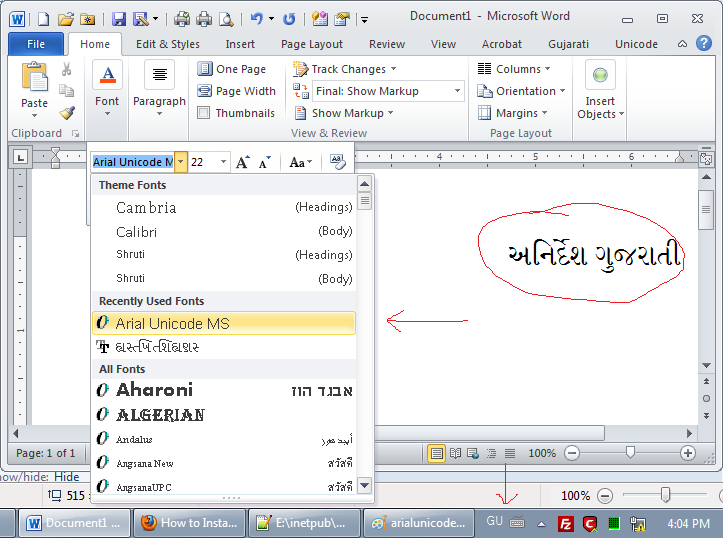Step 2: Scroll down to reach the entry which pertains to your installed version of Microsoft Office. Click on the 'Change' button. Step 3: Choose 'Add or Remove Features.' And click on 'Next'. Step 4: Click on the circled areas below to expand them as shown. Step 5: Click on the circled option below and 'Arial Unicode MS' will get installed.
- In the Microsoft Office Setup dialog, click Add or Remove Features, then Next. Select Choose advance customization of applications, then Next. Next to Office Shared Features, click the plus sign (+). Next to International Support, click the plus sign (+).
- About the font Arial Unicode MS Arial Unicode MS is free for personal use only. Please, talk with the author for commercial use or for any support. You can use the Arial Unicode MS to create interesting designs, covers, shop and store name and logos. The font Arial Unicode MS is also perfect for branding projects, Homeware Designs, Product.
- I work a lot with Unicode fonts and my fav is 'Arial Unicode MS' it works great on my windows and Mac. However when it comes to iPhone/iPad I can not get this font to work the rendering is completely messed up. This font is listed under. Apps can download the following fonts if necessary: I want to know how can I install this on my iPhone / iPad.
This product is Unicode compatible and can therefore display and input most of the languages in the world, including European, East-European and Asiatic languages. Please note that Crystal Reports 8.5 and below do not support Unicode, however, by selecting a font with the appropriate character set, it is possible to translate reports 8.5 into Hebrew, Arabic, Russian... In the case there is no character sets that include your target language, we recommend that you upgrade your application to support Crystal Reports 9, 10 or 11 reports and use 'Crystal Translator for Crystal Reports 9, 10 and VS .Net 2002-2003-2005' or 'Crystal Translator for Crystal Reports 11'.
Right to left languages such as Arabs and Hebrew are also supported with automatic layout mirroring. Right to Left support includes:
- RTL display of source and translated text in the grid editor and multi-line editor
- RTL input of translated text in the grid editor and multi-line editor
- Layout mirroring of the source report if source and target language reading direction are different
- XLS export/import of RTL text
For more information, refer to the chapter 'Right to left languages and mirroring'.
We recommend that you run a test translation to check the support of the source and target languages you need.
Currently, dictionaries for over 30 languages for the ISpell spell checker are available for download from Softlang website:
Belarusian, Bulgarian, Catalan, Czech, Danish, Dutch, English UK, English US, Esperanto, Estonian, Finnish, French, Galician, German, Greek, Hebrew, Hungarian, Italian, Latin, Lithuanian, Maltese, Norwegian, Polish, Portuguese, Romanian, Russian, Slovak, Spanish, Swedish, Tatar, Ukrainian
Fonts


Some fonts can display only a limited number of character sets, therefore you may need to change the font of the target report before being able to input foreign languages. 'Arial Unicode MS', for instance, is a font that supports most of the languages. Please refer to the 'Fonts and languages' chapter for more information on how to change the font as well as the replacement font setting in the TM. You will also need to make sure that your operating system can handle such characters, follow this link for more information. For instructions on how to install 'Arial Unicode MS', see below.
You may also need to distribute the target fonts with the target report to ensure the report runs on any installation if the font you selected are not available on the end user machine.
If you are having trouble viewing and editing text in Chinese, Japanese or Greek for instance, you need to install a font that support such character set. Microsoft provides a special font 'Arial Unicode MS' that can help. All of the following products have this font:
- Microsoft Office XP
- Microsoft Word 2002
- Other Microsoft products: Access 2000, Excel 2000, FrontPage 2000, Office 2000 Premium, Outlook 2000, PowerPoint 2000, Publisher 2000 and Word 2000
How do I install the Arial Unicode MS font?
The Arial Unicode MS font is installed as part of the Microsoft Office Setup and is part of the International Support features. To install the Arial Unicode MS font, follow these steps:

Install Arial Unicode Ms Font
- Click Start, point to Settings, and then click Control Panel. NOTE: In Microsoft Windows XP and Windows Vista, click Start and then click Control Panel.
- In Control Panel, click Add/Remove Programs. Note: In Microsoft Windows Vista, click Programs and Features
- Do one of the following.
- In Microsoft Windows 98, Microsoft Windows Millennium Edition (Me), or Microsoft Windows NT 4.0:
On the Install/Uninstall tab, click Microsoft Office (or Microsoft Word 2002), and then click Add/Remove. - In Microsoft Windows 2000 or Microsoft Windows XP:
Click Change or Remove Programs, click Microsoft Office (or Microsoft Word 2002), and then click Change. - In Microsoft Windows Vista
Click Microsoft Office (or Microsoft Word 2002), and then click Change
- In Microsoft Windows 98, Microsoft Windows Millennium Edition (Me), or Microsoft Windows NT 4.0:
- In the Features to install window, click Next.
- Click to expand Office Shared Features.
- Click to expand International Support.
- Click the icon next to Universal Font, and then click Run all from My computer on the shortcut menu.
- Click Update to complete the installation of the Universal Font (Arial Unicode MS) to your computer.
